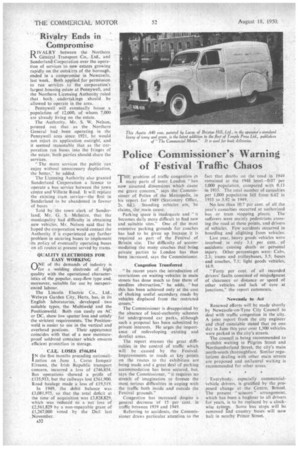Police Commissioner's Warning of Festival Traffic Chaos
Page 34

If you've noticed an error in this article please click here to report it so we can fix it.
T"'problem of traffic congestion in many parts of inner London "has now assumed dimensions which cause me grave concern," says the Commissioner of Police of the Metropolis, in his report for 1949 (Stationery Office, 2s. 6d.). Standing vehicles are, he claims, the main cause.
Parking 'space is inadequate and "it becomes daily more difficult to find new and suitable sites." One of the Most extensive parking grounds for coaches has had to be given up because it is required as part of the Festival of Britain site. The difficulty of accommodating the many coaches that bring private parties to London has thus been increased, says the Commissioner.
Congestion Transferred
"In recent years the introduction of restrictions on waiting vehicles in main streets.has done much to free them of needless obstruction," he adds, "but this has been achieved only at the cost of choking useful secondary roads by vehicles displaced from the restricted streets."
The Commissioner is disappointed by the absence of local-authority schemes for underground car parks, although such a proposal has been submitted by private interests. He urges the importance of redeveloping existing and derelict areas.
The report stresses the great difficulties in the control of traffic which will be caused by the Festival. Improvements to roads at key points on the routes to the exhibition are being made and a great deal of parking accommodation has been secured, but, says the Commissioner, "it requires no stretch of imagination to foresee the most serious difficulties in coping with the traffic both inside and outside the Festival grounds."
Congestion has increased despite a general decrease of 15 per cent, in traffic between 1939 and 1949.
Referring to accidents, the Commissioner draws particular attention to the fact that deaths on the road in 1949 remained at the 1948 level-0.07 per 1,000 population, compared with 0.13 in 1935. The total number of casualties per 1,000 population fell from 6.62 in 1935 to 3.92 in 1949.
No less than 10,7 per cent, of all the year's casualties occurred at authorized bus or tram stopping places. The sufferers were mainly pedestrians crossing the road at these points, and drivers of vehicles. Few accidents occurred in boarding and alighting from vehicles.
Last year, heavy goods vehicles were involved in only 3.1 per cent. of accidents causing death or personal injury. Other percentages were: Cabs, 2.3; trams and trolleybuses, 3.5; buses and coaches, 7.1; light goods vehicles, 16.9.
"Forty per cent. of all recorded drivers' faults consisted of misjudgment of clearance or distance or speed of other vehicles and lack of care at junctions," the report comments.
Newcastle to Act
Renewed efforts will be made shortly by Newcastle-on-Tyne City Council to deal with traffic congestion in the city. A joint report from the city engineer and chief constable stated that on one day in June this year over 1,300 vehicles were parked in the city's streets.
The council is being recommended to prohibit waiting in Pilgrim Street and Northumberland Street, the city's main north-south thoroughfare. Similar regulations dealing with other main streets are proposed and unilateral waiting is recommended for other areas.
Everybody, especially commercialvehicle drivers, is gratified by the proposed change at the Centre, Bristol. The present "scissors" arrangement, which has been a bugbear to all drivers for years, is to be replaced by a clockwise sySteln. Some bus stops will be removed Ind country buses will now halt in nearby Prince Street.












































































